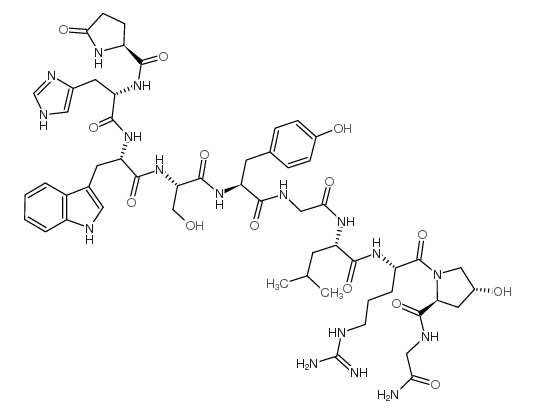Preferential distribution of C-terminal fragments of [hydroxyproline9]LHRH in the rat hippocampus and olfactory bulb.
J P Gautron, E Pattou, P Leblanc, A L'Héritier, C Kordon
文献索引:Neuroendocrinology 58(2) , 240-50, (1993)
全文:HTML全文
摘要
Several molecular forms related to the decapeptide LHRH were characterized and quantified in various brain structures of intact and castrated male and female rats. Distinct moieties were separated by high performance liquid chromatography (HPLC) and radioimmunoassayed against anti-LHRH antibodies of different specificities. The hypothalamus contained the highest concentration of LHRH-like material detected by the antisera. The predominant (89%) molecular form recovered from that structure was LHRH itself; 9% of the material corresponded to [hydroxyproline9]LHRH ([Hyp9]LHRH), an endogenous posttranslational product of the LHRH precursor, and the residual immunoreactivity was accounted for by C-terminal fragments of both decapeptides, as assessed after labelling HPLC columns with appropriate synthetic or endogenous hypothalamic peptides. The proportions were the same in both sexes and were not affected by castration, in spite of a lesser overall LHRH activity in females and in castrates. LHRH and [Hyp9]LHRH were also detected in the olfactory bulb and the hippocampus. In these structures however, most (97%) LHRH-related molecules corresponded to C-fragments derived from [Hyp9]LHRH, whereas only very few fragments derived from the nonhydroxylated decapeptide were found. Sex or castration affected neither total nor relative concentrations of LHRH-derived molecules in the olfactory bulb and the hippocampus. Taken altogether, these observations are suggestive of a different LHRH metabolic regulation in neurons projecting to either the median eminence or extrahypothalamic areas. In the latter case, larger amounts of the LHRH precursor appear processed to [Hyp9]LHRH. Recovery of relatively high concentrations of [Hyp9]LHRH C-fragments in the olfactory bulb and the hippocampus reflects the higher resistance of the Hyp9-Gly10-NH2 than the Pro9-Gly10-NH2 peptide bond to hydrolysis by the postproline cleaving enzyme. In view of reports that intracerebral administration of C-terminal fragments of LHRH are able to trigger sex behavior, our finding that extrahypothalamic structures contain relatively high concentrations of the [Hyp9]LHRH-derived, more stable C-fragments suggests that these catabolites may have a role in the regulation of sex behavior.
相关化合物
| 结构式 | 名称/CAS号 | 分子式 | 全部文献 |
|---|---|---|---|
 |
pglu-his-trp-ser-tyr-gly-leu-arg-hyp-gly-nh2
CAS:67019-13-0 |
C55H75N17O14 |
|
Luteinizing hormone-releasing hormone (LHRH)- and (hydroxypr...
1992-05-01 [Endocrinology 130(5) , 2871-6, (1992)] |
|
A second endogenous molecular form of mammalian hypothalamic...
1992-05-01 [Mol. Cell. Endocrinol. 85(1-2) , 99-107, (1992)] |
|
Characterization of [hydroxyproline9]luteinizing hormone-rel...
1995-04-28 [Mol. Cell. Endocrinol. 110(1-2) , 161-73, (1995)] |
|
In vitro secretion of gonadotropin-releasing hormone (GnRH) ...
1998-10-01 [Neuroendocrinology 68(4) , 281-92, (1998)] |
|
Differential in vitro secretion of gonadotropin-releasing ho...
2000-09-01 [J. Neuroendocrinol. 12(9) , 919-26, (2000)] |